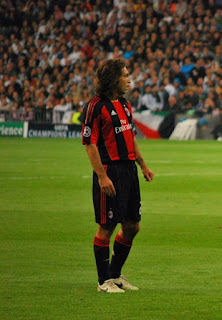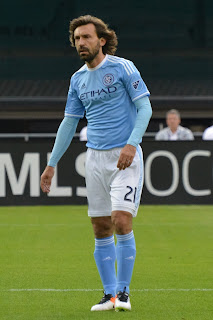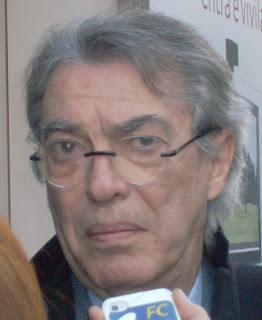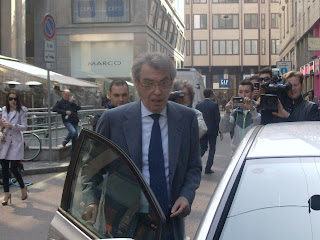Midfielder who won multiple honours with AC Milan and Juventus
 |
| Andrea Pirlo made 119 career appearances for the Italian national team |
The midfielder, who left Italy to join the
Major League Soccer team New York City, has played in six Italian
championship-winning teams and is a double winner of the Champions League among
a host of honours as a club player.
In international football he has a World Cup winner’s medal
as a member of the 2006 Italian national team that lifted the trophy in
Germany. The fulcrum of the Azzurri
midfield, he scored one goal and was credited with the assist for three other
goals during the tournament.
One of those assists resulted in the crucial opening goal
for Italy scored by Fabio Grosso in the classic semi-final against the host
nation. He was also one on Italy’s
successful penalty takers during the shoot-out that decided the final against
France.
He was named man of the match three times in the tournament,
more than any other player. He matched
that achievement six years later at Euro 2012, when Italy were beaten in the
final.
In all he won 119 caps for his country, the fourth highest
total of all Italian internationals. Fellow players nicknamed him l’architetto –
the architect – for his ability to design and construct attacking moves.
Although he began his career as an attacking midfielder or
sometimes even a second striker, Pirlo excelled as a deep-lying central
midfielder, a playmaker with wonderful vision and the ability to hit accurate
passes over any distance.
 |
| Pirlo won three Serie A titles with Juventus |
He also acquired renown as a free kick specialist, capable
of curling the ball into the net beyond the reach of the goalkeeper. He claims
he honed his technique by watching Baggio train at Brescia, the club at which
Baggio wound down his career and Pirlo began his.
Pirlo was born in Flero, Italy, in the province of Brescia
and began his career with the Flero youth side. He joined Brescia in 1994 and
made his debut in Serie A in May the following year at the age of 16, although
it took him a further 18 months to win consistent selection for the senior
side.
When he did, Brescia won the Serie B title and with it
promotion to Serie A in 1998. It won him a move to Internazionale of Milan but
could not break into the first team permanently and was loaned to Reggina for
the 1999-2000 season and then back to Brescia in 2000-01, where he played
alongside Baggio, his childhood idol.
Because Baggio occupied the attacking midfield position for
Brescia, manager Carlo Mazzone decided to deploy Pirlo in the deep-lying playmaker
role that he would make his own. Years later, Pirlo still described the moment
he delivered a long pass that enabled Baggio to score against Juventus as one
of the high spots of his career.
After three seasons on Inter’s books, Pirlo was sold to city
rivals AC Milan for 33 billion Italian lire – just over 17 million euro – in June
2001.
 |
| Pirlo's brilliance as a playmaker emerged under Carlo Ancelotti at AC Milan |
It was at Milan, in particular under Carlo Ancelotti, where Pirlo at
last began to realise his talent and became a world class player.
Recalling Mazzone’s use of him at Brescia, Ancelotti decided
to position Pirlo just in front of his defence, which allowed him more time on
the ball to pull the strings in terms of setting up attacks, where he could use
his, anticipation, imagination and inventiveness to best effect.
He was a key player in a period of consistent success as
Italian football became dominated by Silvio Berlusconi’s AC Milan and MassimoMoratti’s Inter.
Milan won two Champions Leagues (2003 and 2007), two UEFA
Super Cups (2003 and 2007), two Serie A titles (2004 and 2011), a FIFA Club
World Cup (2007), a Supercoppa Italiana (2004), and a Coppa Italia (2003) during
Pirlo’s time.
Baggio himself sang his praises. “Andrea can visualise and
anticipate plays before everyone else. His vision, what he can do with the
ball, and what he's able to create, make him a true superstar,” he said.
After Ancelotti left to become Chelsea manager in 2009, soon
failing with a bid to take Pirlo with him, Pirlo remained with Milan for a
further two seasons, winning the scudetto again in 2011, but new coach
Massimiliano Allegri used him differently and his final season was restricted
to 17 appearances for Serie A, which prompted him to seek a change of
direction.
 |
| Pirlo left Juventus to join MLS club New York City |
But Milan’s loss turned out to be Juventus’s gain after the
so-called Old Lady of Italian football, without a trophy since 2003 after two
Serie A titles in 2005 and 2006 were stripped from them over the match-fixing
scandal, signed him on a free transfer.
Under coach Antonio Conte he added three more Serie A titles
(2012, 2013, 2014), as well as two more Supercoppa Italiana titles (2012 and
2013). When Conte left to become national manager, Pirlo again worked with
Allegri but more successfully this time, playing his part in a league and cup
double in 2015 before leaving for New York.
His final appearance was in the Champions League final – his
fourth – in which Juventus were beaten 3-1 by Barcelona.
One of two children – he has a brother Ivan – Pirlo was
married for 13 years to Deborah Roversi, with whom he had two children, Niccolò
and daughter Angela.
His father founded a metal trading company in Brescia in
1982 called Elg Steel, in which Pirlo has a stake. A wine connoisseur, he also runs
his own vineyard. In 2013, his autobiography,
Penso Quindi Gioco - I Think, Therefore I Play) – became a bestseller.
Travel tip:
Flero, where Andrea Pirlo was born, is a town in Lombardy of
just under 9,000 residents, situated a few kilometres south of Brescia in the
flat plain of the Po Valley, although close enough to the Italian pre-Alps for
snow-capped mountains to be visible on clear winter days. Lake Garda and Lake Iseo are a short distance
away. Flero itself is a typical northern
Italian commuter town, orderly and clean with a couple of churches and a few modern
shops.
Travel tip:
The city of Brescia tends not to attract many tourists
compared with nearby Bergamo or Verona, partly because of the
counter-attraction of the lakes. Yet it
has plenty of history, going back to Roman times, and many points of interest,
including two cathedrals – the Duomo Vecchio and its neighbour, the Duomo Nuovo
– and the attractive Piazza della Loggia, with a Renaissance palace, the
Palazzo della Loggia, which is the town’s municipal centre. The Torre dell’Orologio clock tower bears
similarities to the one in St Mark’s Square in Venice.
More reading:
The genius of Roberto Baggio
Fabio Grosso - a career defined by one goal
How Antonio Conte led Juventus back to the top
Also on this day:
1946: The birth of actor Michele Placido













